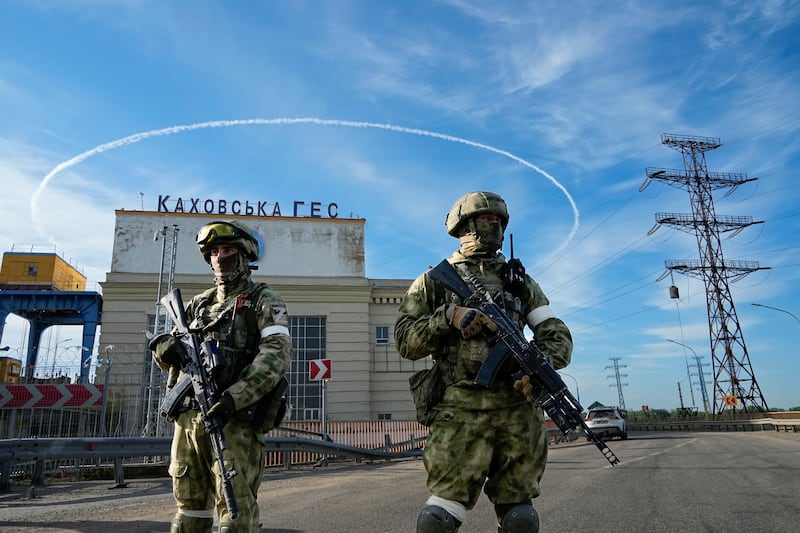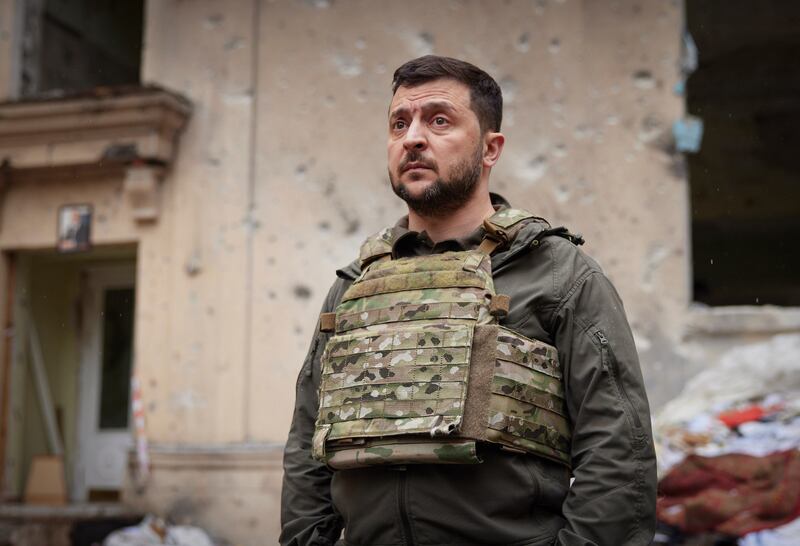One hundred days of all-out war have disproved much of what the Kremlin thought it knew about Ukraine, but Russia still believes it can wear down its neighbour’s defences and the West’s willingness to pay a price for backing Kyiv.
Russia launched a full-scale invasion of Ukraine on February 24th with too few troops spread too thinly over too many fronts, suggesting it expected Ukraine’s military to fold, its political leadership to flee, and many of its 42 million people to welcome occupation.
None of those things happened, and Russian units were destroyed and driven back from the suburbs of Kyiv in early April, then forced to retreat last month from near Kharkiv, Ukraine’s second city, which is just 35km from the border between the former allies.

Yet this grim landmark in a war that has already killed tens of thousands of people and displaced 14 million finds Russia seizing territory in the Donbas region of eastern Ukraine and eyeing cracks in western support for Kyiv that it intends to turn into chasms.
READ MORE
“They’ve scaled down their objectives. Now they’re better able to resource their forces in the Donbas appropriately, in a way they couldn’t ... when they were spread far too thinly to achieve what they wanted, especially given the level of resistance they faced,” says Nick Reynolds, research analyst for land warfare at the Royal United Services Institute (Rusi).
“Now they are moving forward and taking ground, and Ukraine is having to fight with huge determination just to slow them down.”
Before February 24th, Moscow’s proxy militia held about one-third of Donbas, a coal-rich area comprising Donetsk and Luhansk regions that was formerly Ukraine’s industrial heartland, but now the Kremlin’s forces occupy about three-quarters of the area.
Russia’s progress is slow, however, and military analysts and Ukrainian soldiers say it is relying on the superior range and firepower of its artillery to blast its way into villages, towns and cities that are being largely destroyed as a result – turning places such as Mariupol, Popasna, Izyum and now Severodonetsk and neighbouring Lysychansk into ruins.

Ukraine’s troops are being pushed back in Donbas, but their tactical retreats allow them to save manpower and weaponry while slowing Russia’s advance and avoiding the kind of disastrous encirclements that befell them in 2014 and 2015 battles in the region.
“I would put that very much on the Russians and their poor performance. The Ukrainians are under a huge amount of pressure but when have chosen to withdraw they do seem to have the space to do so,” says Reynolds.
“What you might expect to see from an advancing army is that when they create an opening, they use it to break through and exploit, which is what the Russians don’t seem to be doing very well – they are moving very incrementally,” he explains.
“The Russians are not fighting very well on the operational level, which is contributing to the Ukrainian ability to withdraw in control.”
Ukraine currently lacks the firepower to drive back Moscow’s military on the plains of Donbas, however, so a summer of brutal artillery exchanges and a bloody, destructive Russian grind towards the cities of Slovyansk and Kramatorsk appears to be ahead.
“Ukrainian forces are really positioned all across that [area], making it very punishing for Russia to try to close it. This is why we see very contested positions today around places like Severodonetsk, Popasna and Bakhmut,” says Mathieu Boulègue, a senior research fellow of the Russia and Eurasia programme at Chatham House.

“It will be all the more punishing because when Russia finally gets to positioning its forces to prepare for the battles for Kramatorsk and Slovyansk, Ukraine will have had time to prepare for their defence,” he adds.
The neighbouring cities, which had a combined pre-war population of about 250,000 people, were held by Russian-led militants for a few months in 2014 before Ukraine counter-attacked and took them back – giving them particular significance for both states.
“There’s probably a sense of revenge for Russia to get both these cities. And if revenge leads to frustration, we can’t rule out that Russia would try to inflict a lot of pain on them through heavy bombardment and indiscriminate shelling,” says Boulègue.
“It is becoming increasingly hard for Russia to really push and move by subduing territory quickly. This is a very slow-moving steamroller – it’s still a steamroller because it’s the Russian army – but it is very slow in gaining ground, and then it has to keep that ground and limit the amount and the quality of [Ukrainian] counter-offensives.”
Ukraine says its forces have been counterattacking in recent days in the southern region of Kherson, which was largely occupied early in the all-out war by Russian troops that poured into the area from nearby Crimea, which the Kremlin annexed in 2014.
But analysts doubt that Kyiv’s military has the available troops and weaponry to retake and hold the Kherson region or its namesake capital, where Moscow has installed collaborationist officials who are now talking about rapidly “integrating” it with Russia.
“If they can’t fully conquer [the area] then they need to subdue it, and the best way to do so is to absorb it, to Russify these territories,” says Boulègue.
“This is what they are preparing now for Kherson, in terms of financial institutions, the Russian school curriculum and language, administrative processes and so on. They are placing their people in the right places to control these territories by force.”

Many Ukrainians hope their military will be able to turn the tables on Russia once it has a sufficient stock of the advanced weapons that western powers pledge to Kyiv almost every day: the last week alone has seen the US and Britain promise advanced multi-launch rocket systems (MLRS), Germany offer a high-tech air-defence system and Denmark start sending Harpoon anti-ship missiles.
Yet there is no “silver bullet” that will give Ukraine battlefield superiority.
[ The foreign volunteers training Ukraine’s new recruitsOpens in new window ]
Reynolds at Rusi says it could be months before Ukraine’s forces receive, master and fully integrate the new MLRS batteries with other systems – from reconnaissance drones to secure communications – that will allow them to have maximum impact on the enemy.
So-called combined arms manoeuvre “is a complex capability with lots and lots of components – it’s not just about the guns or the tubes”, he says, referring to field guns and MLRS systems.
“You need all the different components there, and everyone understanding how the system works and being able to do their part in that system ... All this when added together will take time.”
Time means attrition and mounting casualties for both sides: Ukrainian president Volodymyr Zelenskiy said this week that 60-100 of his country’s soldiers were dying every day and another 500 were being injured; Moscow has not released casualty figures since March, but the British defence ministry estimates that it has already lost as many troops in Ukraine as it did during nine years of war in Afghanistan, when more than 15,000 Soviet soldiers died or disappeared.
Marina Miron, an honorary research fellow at the defence studies department of King’s College London, notes that Russian and Ukrainian forces are reportedly sending some inexperienced soldiers into battle with little training.

“I think they can do it to a certain point until there is a backlash. There have been reports of Russians and Ukrainians abandoning their positions and fleeing,” she says.
“Russia has lost a lot of highly qualified professionals there, colonel- and general-level commanders in the field... I think Russia will limit itself to taking the Donbas region, because I cannot see how it would go further without mobilising more people.”
With its new, painfully acquired and greatly diminished notion of what it can achieve quickly in Ukraine, Russia appears to view the capture of the Donbas and Kherson regions as a potential – at least preliminary – “mission-accomplished” moment, when it will try to freeze the frontline and press western states to help it foist an unpalatable deal onto Kyiv.
“I think that’s exactly what Russia is pushing for,” says Reynolds.
“And I think that if certain European countries are involved in that process as mediators, then they would push for that as well. France, for example, has been pretty open about desiring a return to the status quo... and for a negotiated settlement.”

Europe grapples with Ukraine, food and energy crises
Not without difficulty, EU member states reached an agreement on new sanctions against Russia, this time banning most oil imports. Pat Leahy and Naomi O'Leary were at the summit.
The EU’s struggle this week to agree on a partial oil embargo against Russia indicates how hard it will be for western states to maintain unity on sanctions if fuel and food prices continue to rise into the autumn and winter.
“Sanctions didn’t stop the war and Russia is not doing that poorly right now – it is still in the Opec+ group [of oil exporters] and has other friends that it has been cultivating for the past 20 years in south-east Asia, India, China and Arab states,” says Miron.
“Is Europe wiling to destroy itself economically to stop this war? And what about defence spending – where are we going to get the money to replace the equipment that we are sending to Ukraine? Someone has to pay for it and the average taxpayer may get tired of that... and could start saying: ‘Who do you care more about, your own citizens or Ukraine?’”

If a bloodied Russia is now looking more realistically at Ukraine, it will see a country that will not accept occupation: national polling last month by the Kyiv International Institute of Sociology showed that 82 per cent of Ukrainians opposed making any territorial concessions to Moscow, even if such a stance prolonged the war, and only two per cent had a positive attitude towards Russia, down from 34 per cent in early February.
Ukrainians insist that they will not – cannot – tire of a battle with a Kremlin that they accuse of launching a genocidal campaign to wipe their nation off the map, and any western attempts to railroad Kyiv into an unfavourable deal with Russia, similar to the Minsk agreements of 2014 and 2015, appear doomed.
“I don’t think the Ukrainian government would ever accept Germany and France as mediators again after what happened with Minsk, and I don’t think it would ever come to any deal that is similar,” says Reynolds.
“If a Zelenskiy government attempted to negotiate similar terms, or to cede Ukrainian territory, then there wouldn’t be a Zelenskiy government for much longer.”



















